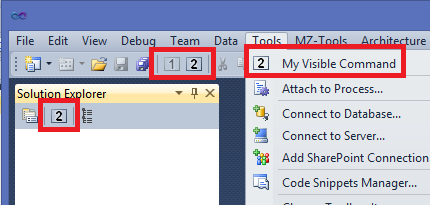While migrating my MZ-Tools add-in to a package, I found an issue: I wanted a button to be initially invisible on my toolbar. By “initially” I mean before the package is loaded, that is, declaring the invisibility in the .vsct file using:
<CommandFlag>DynamicVisibility</CommandFlag> <CommandFlag>DefaultInvisible</CommandFlag>
However, the button appeared initially disabled rather than invisible. Investigating I found this reported in the MSDN VSX forum as back as in 2006 (VS 2005 I guess) using the old .ctc file rather than the new .vsct file and, guess what, that behavior is “by design”. However, buttons on toolwindows toolbars (rather that on IDE toolbars) can be initially invisible.
I created a sample package to reproduce the problem. The package creates two commands (the first one initially invisible) that are placed in three locations: the Tools menu, the Standard toolbar and the Solution Explorer toolbar. Notice that the button on the Standard toolbar is disabled rather than invisible:
And I have documented this behavior with code in this article:
PRB: Button of package command cannot be initially invisible on Visual Studio toolbar
